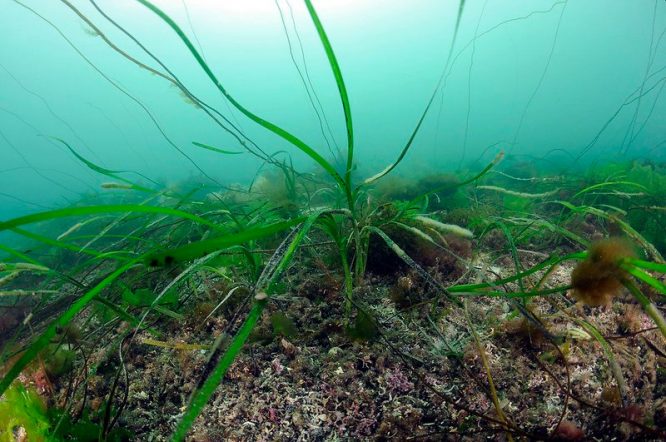
Seagrass © Ben James/NatureScot Flickr
Scotland’s first handbook for seagrass restoration has been published as trials in the innovative technique gather pace.
The handbook has been developed by NatureScot in collaboration with Marine Scotland and Project Seagrass as a result of increasing interest in the potential of restoring marine habitats to store blue carbon, enhance coastal defences and increase biodiversity in our seas.
Seagrasses are marine flowering plants that can grow in dense beds or meadows and are often found in shallow, sheltered areas along the Scottish coastline.
Scotland holds 20% of the seagrass beds in north-west Europe but globally the habitat is in decline as a result of a range of factors including human activities, climate change, invasive non-native species and disease.
Following successful seagrass restoration projects in Wales, attention has turned to the potential for seagrass restoration in Scotland, where trials are in the early stages.
The handbook provides essential information and guidance on all aspects of seagrass restoration, such as site suitability, licensing, biosecurity, techniques and monitoring.
Seagrass Restoration
Environment Minister Mairi McAllan said: ““Seagrass has a key role to play globally in climate change adaptation and mitigation as well as biodiversity restoration and protection, helping us to meet global net-zero targets.
“It provides food and shelter for thousands of different species, which in turn supports the livelihoods of fishing communities.
“For coastal populations which are particularly vulnerable to the impact of climate change, mature seagrass beds have the potential to attenuate wave action, slowing down coastal erosion.
“That is why the new seagrass restoration handbook is so important. It underlines Scotland’s place at the forefront of climate change action both nationally and internationally, building on the work the Scottish Government is already doing to better understand the distribution of these important marine habitats so we can best target our protection and restoration efforts.
“This includes funding for the Scottish Blue Carbon Forum for research and supporting the use of drone-based aerial survey methods to map Scotland’s seagrass habitats through Project Seagrass.”
Climate
Flora Kent, NatureScot’s Marine Enhancement Adviser, said: “COP26 has highlighted the urgent need for nature-based solutions to help tackle the climate and nature crises we are facing – both on land and in the ocean.
“Seagrass beds are a Priority Marine Feature in our seas where they help to store blue carbon and have great benefits for biodiversity. Protecting and enhancing these vital yet sensitive beds is therefore important as a potential nature-based solution in the face of the climate and biodiversity crises.
“However it’s crucial that any restoration project is evidence-based and carefully designed to protect existing habitats and ensure the greatest chance of success. This handbook will help guide projects and ensure that all relevant aspects are considered, as we work to fill any gaps in our knowledge about the conservation and restoration of seagrass beds.”
Dr Richard Lilley of Project Seagrass said “The loss of seagrass in the North Atlantic that has occurred over centuries now creates an opportunity for the start of a period of environmental renewal. At the start of the UN Decade on Ecosystem Restoration it is critical we design seagrass restoration projects that are based on strong, collaborative partnerships using the best available science.”
Seagrass restoration proposals should outline the potential risks and benefits of the project and NatureScot can provide advice on a case-by-case basis. The handbook will be followed by further guidance for marine enhancement and restoration work to be published by NatureScot soon.
Read the full NatureScot Research Report 1286 – Seagrass restoration in Scotland – handbook and guidance
Find out more about NatureScot’s work on marine enhancement
Tags: Community, Priority-features, Restoration, Seagrass